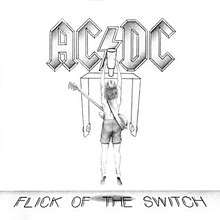Flick of the Switch
| Flick of the Switch | ||||
|---|---|---|---|---|
 |
||||
| Studio album by AC/DC | ||||
| Released | 15 August 1983 | |||
| Recorded | Compass Point Studios, Nassau, Bahamas, April 1983 | |||
| Genre | Hard rock | |||
| Length | 37:02 | |||
| Label | Albert, Atlantic, Sony | |||
| Producer | AC/DC | |||
| AC/DC chronology | ||||
|
||||
| Singles from Flick of The Switch | ||||
|
||||
| Professional ratings | |
|---|---|
| Review scores | |
| Source | Rating |
| Allmusic |
|
| Blender |
|
| Rolling Stone |
|
Flick of the Switch is the ninth studio album by Australian hard rock band AC/DC. Released in 1983, it followed the highly successful Back in Black and For Those About to Rock albums. Flick of the Switch is the third AC/DC album to feature lead vocalist Brian Johnson, and last to feature drummer Phil Rudd before his eleven-year break from the band. It is the band's eighth internationally released studio album, the ninth to be released in their native Australia. All songs on the album were composed by guitarists Malcolm and Angus Young and vocalist Johnson.
Flick of the Switch was re-released in 2003 as part of the AC/DC Remasters series.
AC/DC returned to Compass Point Studios in the Bahamas to record their ninth album, the same studio where they had recorded Back in Black with Robert John "Mutt" Lange in 1980. Lange had produced AC/DC's three previous releases but this time the band chose to produce themselves. On the recorded commentary on the album for the Live at Donington DVD, the band members state that the album was an attempt to make the band raw again, and were happy with the result. In the book AC/DC: Maximum Rock & Roll, AC/DC engineer Tony Platt recalls:
The album is notable for its "dry" sound, with very little of the polish that is evident on their previous effort For Those About to Rock We Salute You. In a 1983 interview that appears on ultimateguitar.com, Angus Young said of the LP, "We wanted this one as raw as possible. We wanted a natural, but big, sound for the guitars. We didn't want echoes and reverb going everywhere and noise eliminators and noise extractors." However, the album's birth was a troubled one; after having problems with Malcolm as well as drugs and alcohol, drummer Phil Rudd was fired midway through the album's recording sessions, although he had completed his drum parts. According to Murray Engleheart's band memoir AC/DC: Maximum Rock & Roll, Rudd had been struggling for some time; tour manager Ian Jeffrey recalls getting a phone call from a strung-out Rudd at four in the morning when the band was playing in Nebraska on the Back in Black tour and finding the drummer in his hotel room in a state of disorientated agitation. Eventually Rudd broke down crying and begged Jeffery "Don't tell Malcolm." Jeffery also reveals that Malcolm punched the drummer after he showed up two hours late for the band's show at Long Island's Nassau Coliseum and was unable to play the last song of the encore. "It was an absolutely stupid thing that finished it, but it had been brewing for a long, long time," Jeffery remembers. "He got into drugs and got burned out," Malcolm later explained to KNAC.com in August 2000. Former Procol Harum drummer B.J. Wilson was hired to help complete the recording if needed, but his contributions were not used. Platt later recalled to band biographer Jesse Fink, "It wasn't a happiest of albums. There were all sorts of tensions within the band. They were all pretty knackered by that point. It was the album that copped the backlash, really." The drum position was eventually filled by future Dio drummer Simon Wright after more than 700 auditions were held in the U.S. and UK.Simon Kirke of Free and Bad Company fame, and Paul Thompson of Roxy Music were two of the drummers auditioned. Wright appeared in the videos for "Flick of the Switch", "Nervous Shakedown", and "Guns For Hire". A second video for "Nervous Shakedown" was also shot at a pre-show rehearsal at Joe Louis Arena in Detroit. He also toured for the album, and is seen in the pro-shot video recordings from that period. The videos, which were shot in an aircraft-hangar sized area, seemed to reflect the stripped-down sound of the album and flew in the face of the growing infatuation that the music business was developing with the glitz of MTV.
...
Wikipedia
